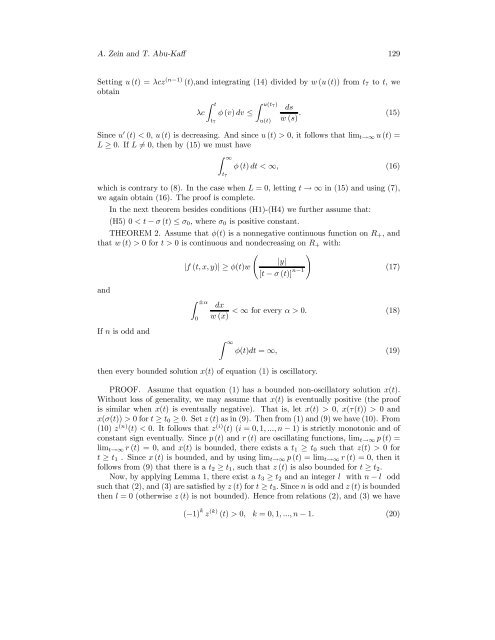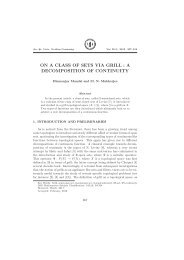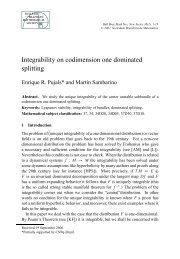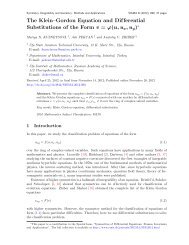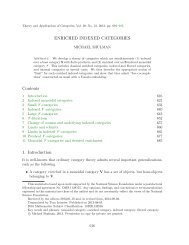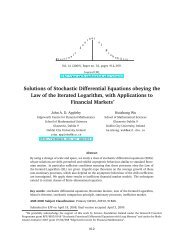Bounded Oscillation Of Higher Order Neutral Differential Equations ...
Bounded Oscillation Of Higher Order Neutral Differential Equations ...
Bounded Oscillation Of Higher Order Neutral Differential Equations ...
Create successful ePaper yourself
Turn your PDF publications into a flip-book with our unique Google optimized e-Paper software.
A. Zein and T. Abu-Kaff 129Setting u (t) =λcz (n−1) (t),and integrating (14) divided by w (u (t)) from t 7 to t, weobtain t u(t7 )dsλc φ (v) dv ≤t 7 u(t) w (s) . (15)Since u (t) < 0, u (t) is decreasing. And since u (t) > 0, it follows that lim t→∞ u (t) =L ≥ 0. If L = 0, then by (15) we must have ∞φ (t) dt < ∞, (16)t 7which is contrary to (8). In the case when L = 0, letting t →∞in (15) and using (7),we again obtain (16). The proof is complete.In the next theorem besides conditions (H1)-(H4) we further assume that:(H5) 0 0fort>0 is continuous and nondecreasing on R + with:|y||f (t, x, y)| ≥ φ(t)w[t − σ (t)] n−1 (17)andIf n is odd and ±α0dx< ∞ for every α > 0. (18)w (x) ∞φ(t)dt = ∞, (19)then every bounded solution x(t) of equation (1) is oscillatory.PROOF. Assume that equation (1) has a bounded non-oscillatory solution x(t).Without loss of generality, we may assume that x(t) is eventually positive (the proofis similar when x(t) is eventually negative). That is, let x(t) > 0, x(τ(t)) > 0andx(σ(t)) > 0fort ≥ t 0 ≥ 0. Set z (t) as in (9). Then from (1) and (9) we have (10). From(10) z (n) (t) < 0. It follows that z (i) (t) (i =0, 1, ..., n − 1) is strictly monotonic and ofconstant sign eventually. Since p (t) andr (t) are oscillating functions, lim t→∞ p (t) =lim t→∞ r (t) =0, and x(t) is bounded, there exists a t 1 ≥ t 0 such that z(t) > 0fort ≥ t 1 . Since x (t) is bounded, and by using lim t→∞ p (t) = lim t→∞ r (t) =0,thenitfollows from (9) that there is a t 2 ≥ t 1 ,suchthatz (t) is also bounded for t ≥ t 2 .Now, by applying Lemma 1, there exist a t 3 ≥ t 2 and an integer l with n − l oddsuch that (2), and (3) are satisfied by z (t) fort ≥ t 3 . Since n is odd and z (t) isboundedthen l =0(otherwisez (t) is not bounded). Hence from relations (2), and (3) we have(−1) k z (k) (t) > 0, k =0, 1, ..., n − 1. (20)


